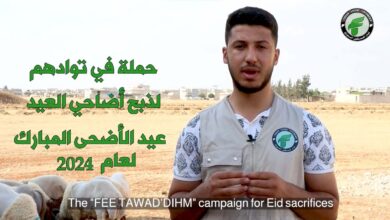Agriculture in Northern Syria: A Catalyst for Development

Introduction:
Northern Syria is a region rich in natural resources, especially fertile agricultural land, which constitutes one of the most important economic sectors in the area. Agriculture has played a pivotal role in the lives of the residents of Northern Syria for centuries, providing them with a primary source of food and income.
Agriculture in northwestern Syria is renowned for several important agricultural products. These include:
- Grains: Wheat, the most important crop in northwestern Syria, is cultivated over large areas and forms the foundation of food security in the region. Barley is used as animal feed and in the production of some food products.
- Legumes: Such as chickpeas, fava beans, and lentils, which are a rich source of protein.
- Oil crops: Olive cultivation is one of the oldest agricultural practices in northwestern Syria, producing high-quality olive oil.
- Vegetables: Such as tomatoes and cucumbers.
- Fruits: Grapes are one of the most important crops in northwestern Syria, with the region producing many varieties of grapes, as well as apples and peaches.
In addition to these products, northwestern Syria cultivates many other agricultural products, such as spices like coriander, mint, and fennel, medicinal herbs like thyme, sage, and chamomile, and fruit trees like apricots, pears, and pine.
These agricultural products contribute to food security in the region, provide income for farmers, and support the local economy. The importance of this article is to highlight the significance of agriculture in Northern Syria as a driver for development and progress.
Contribution of Agriculture to the Local Economy:
By analyzing agricultural productivity, the value of agricultural exports, and the employment opportunities provided by agriculture, it becomes evident that agriculture is a major sector in Northern Syria’s economy. It provides more than 20% of employment opportunities and 30% of the GDP, significantly contributing to food security. The region produces enough agricultural resources to meet the minimum needs of the local population, excluding exports.
However, Northern Syria faces challenges from the war, which has destroyed agricultural infrastructure, displaced farmers, and reduced productivity. Additionally, shortages of resources such as water and energy hinder agricultural development efforts. Drought and extreme weather events also threaten agricultural productivity. Therefore, investing in agricultural infrastructure such as irrigation systems, roads, and storage facilities is essential. Supporting small farmers by providing funding, training, and modern technologies is necessary, along with developing irrigation techniques to increase water use efficiency and adapting to climate changes by cultivating drought-resistant crops and using climate-smart agricultural techniques.
Agriculture is a promising sector in Northern Syria, with great potential to increase productivity and exports. The contribution of agriculture to the local economy varies from region to region in Northern Syria, making it necessary to conduct more research and field studies, which we are working on in the Economic Office of the Syrian Future Movement (SFM), to accurately assess agriculture’s contribution to the local economy.
Challenges Facing Agriculture in Northern Syria:
The challenges include several issues:
- Water scarcity: Water scarcity is one of the most prominent challenges facing agriculture in northwestern Syria, as the region suffers from low rainfall and declining groundwater levels. This problem is exacerbated by the destruction of irrigation infrastructure during the ongoing war and the use of unsustainable irrigation methods.
- Military conflict: The Syrian war has had catastrophic effects on the agricultural sector in northwestern Syria, destroying much agricultural land and infrastructure, displacing many farmers, and significantly reducing productivity, in addition to the loss of livestock.
- Political instability: This affects investment in the agricultural sector, hindering agricultural development efforts and making it difficult for farmers to obtain financing and agricultural inputs. It also demoralizes farmers and reduces their incentive to invest in their land.
- International sanctions: International sanctions imposed on the Syrian regime affect farmers’ ability to export their products, leading to lower prices and reduced profits. It also makes it difficult for farmers to obtain production inputs such as seeds, fertilizers, and pesticides.
- Climate changes: Such as drought and extreme weather events.
- Pests and diseases: Farmers in northwestern Syria face these challenges.
- Lack of knowledge and skills: Necessary for practicing modern agriculture, leading to reduced productivity. Therefore, training programs are needed to teach farmers modern agricultural techniques, such as drip irrigation and organic farming.
- Weak infrastructure: Hinders the transportation of agricultural products to markets, necessitating investment in improving infrastructure, such as roads and storage facilities.
- Lack of financing: Farmers in northwestern Syria face difficulty obtaining the necessary financing to purchase production inputs and invest in their land. Thus, financing programs to support farmers, such as loans and grants, are needed.
- Weak organization: This affects the quality of agricultural products and their ability to compete in external markets.
Data and Figures:
Accurate data on economic growth in northwestern Syria is unavailable due to the lack of a reliable statistical system. However, some estimates indicate that the economy grew slowly in 2023, thanks to the recovery of some sectors such as agriculture and trade. Economic growth is expected to continue moderately in 2024. Unemployment rates in northwestern Syria are high, estimated at over 50%, with young people finding it very difficult to find job opportunities. The ongoing war and lack of investment contribute to high unemployment rates. Regarding poverty, a large proportion of the population in northwestern Syria suffers from poverty, with the poverty line estimated at $200 per month for a family, not per individual! Additionally, it is estimated that 1.3 million people suffer from acute food insecurity.
Conclusion:
The northern region of Syria offers many agricultural opportunities, including rich natural resources, a strategic geographic location, and a young workforce. Undoubtedly, there are many suggestions for solutions to overcome challenges, such as investing in agricultural infrastructure, developing irrigation techniques, and supporting small farmers. However, in the Economic Office of the Syrian Future Movement (SFM), we emphasize the importance of raising policymakers’ awareness of the significance of agriculture in Northern Syria, attracting investments to the agricultural sector, supporting small farmers, and contributing effectively to achieving sustainable development in Northern Syria.
Agriculture is a vital sector in Northern Syria, playing a pivotal role in achieving development and progress. This article aims to highlight the need to assess agriculture’s contribution to the local economy, study the challenges it faces, propose solutions to overcome them, and analyze its role in achieving sustainable development. We are pleased to participate in this with decision-makers from the current authorities in the region through our Economic Office to improve the agricultural reality in Syria.
Ammar Al-Amouri
Economic Office
Research and Studies Department
Articles






